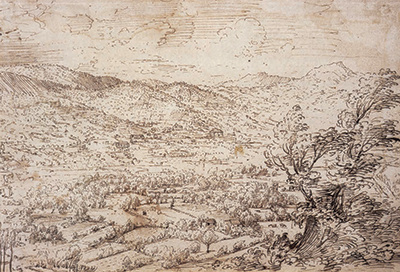The mountainous landscape of Northern Europe appears here within a drawing from the career of Pieter Bruegel the Elder - the first in a family dynasty which would help to shape the future of landscape painting.
He would have to travel in order to find such rolling hills as this, as much of his own local region was fairly flat. Bruegel also took inspiration from various books from time to time, which was somewhat of a necessity in the days before the modern media and the internet. He was fascinated by nature in general, but also in how different regions would vary so much, even just within the confines of this continent. During the 16th century landscape art was not particularly common, with it normally serving as a support to other content, such as portraiture. Bruegel helped to change that within the Northern Renaissance and eventually there would be notable landscape painters right across Europe and beyond. Influence would also later come from Japan too, with the likes of Hiroshige and Hokusai.
Within this composition, we find mountains at the back, with a series of fields leading up to them. In the nearest foreground we are placed on a hilltop, looking down on all of this beauty. Several trees nearby help to increase this sense of perspective and we feel an emotion of comfort and relaxation as we look over this scene which is devoid of humanity. Simple clouds float by in the sky, left very subtle as with most of this artist's drawings. He added more detail to his trees and this would help them stand out, with darker shadows that would only otherwise be used on rockfaces in other compositions. Care was also taken to section out each and every field within this agriculture setting. The piece can now be found in the collection of the Herzog Anton Ulrich Museum (Kupferstichkabinett) in Braunschweig, Germany.
Brown ink pen was used to produce this piece, just as with many of his landscape drawings. It is now dated currently, but a good estimate could be made from similar artworks in his career. The institution that now holds this piece also features original work from the likes of Cranach, Munch, Bosch and Kirchner with a particular interest in North European art, from the Renaissance all the way up to the present day. It remains one of the more significant galleries within the incredible city of Berlin which remains a tourist hotspot within Europe's culture scene. It also has a youthful vibrancy which promises to keep it fresh as new ideas appear across the art world in the future.




